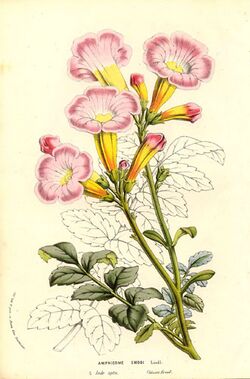Biology:Incarvillea
| Incarvillea | |
|---|---|

| |
| Incarvillea emodi | |
| Scientific classification | |
| Kingdom: | Plantae |
| Clade: | Tracheophytes |
| Clade: | Angiosperms |
| Clade: | Eudicots |
| Clade: | Asterids |
| Order: | Lamiales |
| Family: | Bignoniaceae |
| Tribe: | Tecomeae |
| Genus: | Incarvillea Juss. |
| Species | |
|
See text | |
Incarvillea is a genus of about 16 species[1][2] of flowering plants in the family Bignoniaceae, native to central and eastern Asia, with most of the species growing at high altitudes in the Himalaya and Tibet. The most familiar species is Incarvillea delavayi, a garden plant commonly known as hardy gloxinia[note 1] or Chinese trumpet flower. Unlike most other members of Bignoniaceae, which are mainly tropical woody plants, species of Incarvillea are herbaceous perennial plants from temperate regions.[2]
Genetic analysis supports the division of the genus into five clades: the subgenus Niedzwedzkia, the subgenus Amphicome, the subgenus Incarvillea, the subgenus Pteroscleris, and the species I. olgae, which does not fit into a subgenus. It may be given a subgenus of its own in a future study.[2]
Incarvillea is named after the French Jesuit missionary and botanist Pierre Nicholas Le Chéron d'Incarville.[3]
Species include:
- Incarvillea altissima
- Incarvillea arguta
- Incarvillea beresowskii
- Incarvillea compacta
- Incarvillea delavayi
- Incarvillea dissectifoliola
- Incarvillea emodi (Royle ex Lindl.) Chatterjee
- Incarvillea forrestii
- Incarvillea lutea
- Incarvillea mairei
- Incarvillea olgae
- Incarvillea potaninii
- Incarvillea semiretschenskia
- Incarvillea sinensis (syn. I. variabilis)
- Incarvillea younghusbandii
- Incarvillea zhongdianensis
Chemistry
Incarvillea sinensis contains the alkaloid incarvillateine.[4]
Gallery
Notes
References
- ↑ Incarvillea. Flora of China.
- ↑ 2.0 2.1 2.2 Chen, S. (2005). "Molecular phylogeny of Incarvillea (Bignoniaceae) based on ITS and \[bu100\)TRN\(cmL-Fsequences.". Am. J. Bot. 92 (4): 625–33. doi:10.3732/ajb.92.4.625. PMID 21652440.
- ↑ Incarvillea sinensis 'Cheron Pink'. Missouri Botanical Garden.
- ↑ Nakamura, M.; Chi, Y. M.; Yan, W. M.; Nakasugi, Y.; Yoshizawa, T.; Irino, N.; Hashimoto, F.; Kinjo, J. et al. (1999-09-01). "Strong antinociceptive effect of incarvillateine, a novel monoterpene alkaloid from Incarvillea sinensis". Journal of Natural Products 62 (9): 1293–1294. doi:10.1021/np990041c. ISSN 0163-3864. PMID 10514316.
Wikidata ☰ Q2697376 entry
 |



